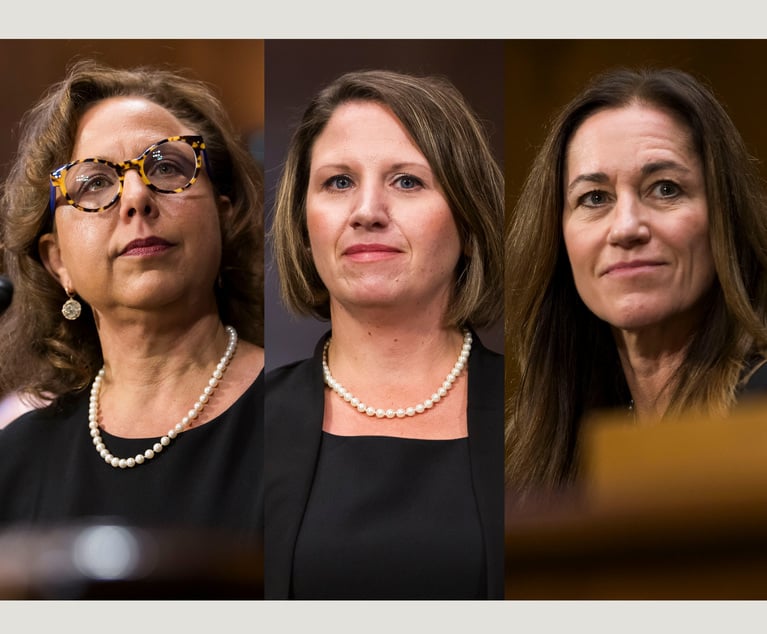Examining the Shutdown's Impact on the EEOC and Charges of Discrimination
Throughout the shutdown, there were numerous news stories concerning the deadlines by which federal courts were expecting to run out of money. As a result, employment litigators and other federal court practitioners questioned whether the shutdown would interfere with their clients' filing deadlines and how it might affect their practices, generally.
February 07, 2019 at 02:41 PM
5 minute read
By Stephen A. Antonelli
 Stephen A. Antonelli, Babst Calland Clements & Zomnir
Stephen A. Antonelli, Babst Calland Clements & ZomnirBy the time you are reading this, the federal government will have re-opened, at least temporarily. On Friday, Jan. 25, the president and Congress agreed to end a 35-day partial shutdown of the U.S. government—the longest in history—by passing a continuing resolution that will fund the government through Feb. 15.
Throughout the shutdown, there were numerous news stories concerning the deadlines by which federal courts were expecting to run out of money. As a result, employment litigators and other federal court practitioners questioned whether the shutdown would interfere with their clients' filing deadlines and how it might affect their practices, generally. Early on, courts were expected to run out of operating funds by Jan. 18. That deadline was later extended to Jan. 25 and then to Feb. 1. Luckily, courts were able to maintain mostly normal operations until the shutdown ended.
Likewise, the shutdown did not affect the National Labor Relations Board (NLRB) or the U.S. Department of Labor (DOL). The same cannot be said for the Equal Employment Opportunity Commission (EEOC), which closed on Dec. 22 and did not reopen until Jan. 28. For the 37 days in between those dates, the EEOC did not process new charges of discrimination and it did not investigate pending charges.
According to the EEOC's website, during the shutdown, most services were unavailable. Its toll-free phone numbers were unstaffed, its digital portals were inaccessible, and intake interviews were cancelled (unless a charging party was in danger of missing a filing deadline). In other words, unless a deadline was nearing, if parties to a charge of discrimination had questions about the status of a charge, those questions were likely unanswered during the shutdown.
Through a notice posted on its website, the EEOC provided information for potential charging parties as well as to those who had already filed and/or responded to a charge. Once posted, the website was not updated until the shutdown had ended and appropriations were enacted. A summary of the information provided by the EEOC is below.
Information Provided for Potential Charging Parties
The EEOC reminded potential charging parties that, generally, they must file charges of discrimination within 300 days of the incident of alleged discrimination. This deadline is only 180 days in states such as North Carolina, Georgia, Alabama, Mississippi or Arkansas, where there is no state fair employment practice agency. The EEOC clearly noted that the shutdown did not serve to extend these filing deadlines. As a result, it advised charging parties who were within 30 days of an expiring statute of limitations (or those who were unsure of a filing deadline) to immediately begin the process of filing a charge by downloading and submitting a pre-charge inquiry. The EEOC accepted pre-charge inquiries throughout the shutdown, but only via hand delivery, mail or fax because its online portal was not available.
The EEOC also advised potential charging parties who were within 30 days of a filing deadline of how to file a timely charge. Charges must be dated and signed in writing (not typed). They must also include the following:
- The charging party's name, address and phone number;
- The name, address and phone number of the respondent;
- The adverse action the charging party believes was discriminatory, when it occurred and the reason it was taken; and
- A request for the EEOC to take remedial action.
Information Provided for Parties to a Charge or Litigation
Despite the shutdown, employers were expected to comply with all deadlines for position statements and requests for i nformation. Employers who typically seek extensions of these deadlines were not likely to have their requests granted during the shutdown as the EEOC did not have adequate staff to consider such requests.
The EEOC advised charging parties who have received notice of their right to sue, that the time limits for commencing litigation in federal court were not suspended as a result of the shutdown. As a result, it advised that charging parties who fail to file suit within the applicable time period set forth in the dismissal notice will lose the right to do so.
All mediations—whether for private or public sector matters—that were scheduled to occur during the shutdown, were cancelled until further notice. Now that the EEOC has resumed operations, mediators will contact the parties in each matter to reschedule the mediation.
During the shutdown, the EEOC continued to accept but did not process Freedom of Information Act (FOIA) requests. Now that the EEOC has resumed operations, it will begin to respond to messages left for the FOIA Requester Service Center and the FOIA Public Liaison in the order in which the messages were received. Depending on the volume of messages received, it may take the EEOC as long as 10 business days (until Feb. 8) to respond to your message.
Finally, all litigation involving the EEOC as a party was suspended unless a continuance had not been granted by the court.
In short, the EEOC resumed operations—at least temporarily—on Jan. 28. Its employees will have more than a month's worth of “catch-up” work to do in addition to their normal responsibilities. Employees, employers and their respective counsel should expect significant delays as the EEOC processes and investigates a presumed backlog of charges of discrimination.
Stephen A. Antonelli is a shareholder in the employment and labor and litigation groups of the aw firm Babst Calland Clements & Zomnir. His practice includes representing employers in all phases of labor and employment law, as well as matters of general litigation. Contact him at [email protected].
This content has been archived. It is available through our partners, LexisNexis® and Bloomberg Law.
To view this content, please continue to their sites.
Not a Lexis Subscriber?
Subscribe Now
Not a Bloomberg Law Subscriber?
Subscribe Now
NOT FOR REPRINT
© 2025 ALM Global, LLC, All Rights Reserved. Request academic re-use from www.copyright.com. All other uses, submit a request to [email protected]. For more information visit Asset & Logo Licensing.
You Might Like
View All
Pa. Federal District Courts Reach Full Complement Following Latest Confirmation

The Defense Bar Is Feeling the Strain: Busy Med Mal Trial Schedules Might Be Phila.'s 'New Normal'
7 minute read
Federal Judge Allows Elderly Woman's Consumer Protection Suit to Proceed Against Citizens Bank
5 minute read
Judge Leaves Statute of Limitations Question in Injury Crash Suit for a Jury
4 minute readTrending Stories
- 1We the People?
- 2New York-Based Skadden Team Joins White & Case Group in Mexico City for Citigroup Demerger
- 3No Two Wildfires Alike: Lawyers Take Different Legal Strategies in California
- 4Poop-Themed Dog Toy OK as Parody, but Still Tarnished Jack Daniel’s Brand, Court Says
- 5Meet the New President of NY's Association of Trial Court Jurists
Who Got The Work
J. Brugh Lower of Gibbons has entered an appearance for industrial equipment supplier Devco Corporation in a pending trademark infringement lawsuit. The suit, accusing the defendant of selling knock-off Graco products, was filed Dec. 18 in New Jersey District Court by Rivkin Radler on behalf of Graco Inc. and Graco Minnesota. The case, assigned to U.S. District Judge Zahid N. Quraishi, is 3:24-cv-11294, Graco Inc. et al v. Devco Corporation.
Who Got The Work
Rebecca Maller-Stein and Kent A. Yalowitz of Arnold & Porter Kaye Scholer have entered their appearances for Hanaco Venture Capital and its executives, Lior Prosor and David Frankel, in a pending securities lawsuit. The action, filed on Dec. 24 in New York Southern District Court by Zell, Aron & Co. on behalf of Goldeneye Advisors, accuses the defendants of negligently and fraudulently managing the plaintiff's $1 million investment. The case, assigned to U.S. District Judge Vernon S. Broderick, is 1:24-cv-09918, Goldeneye Advisors, LLC v. Hanaco Venture Capital, Ltd. et al.
Who Got The Work
Attorneys from A&O Shearman has stepped in as defense counsel for Toronto-Dominion Bank and other defendants in a pending securities class action. The suit, filed Dec. 11 in New York Southern District Court by Bleichmar Fonti & Auld, accuses the defendants of concealing the bank's 'pervasive' deficiencies in regards to its compliance with the Bank Secrecy Act and the quality of its anti-money laundering controls. The case, assigned to U.S. District Judge Arun Subramanian, is 1:24-cv-09445, Gonzalez v. The Toronto-Dominion Bank et al.
Who Got The Work
Crown Castle International, a Pennsylvania company providing shared communications infrastructure, has turned to Luke D. Wolf of Gordon Rees Scully Mansukhani to fend off a pending breach-of-contract lawsuit. The court action, filed Nov. 25 in Michigan Eastern District Court by Hooper Hathaway PC on behalf of The Town Residences LLC, accuses Crown Castle of failing to transfer approximately $30,000 in utility payments from T-Mobile in breach of a roof-top lease and assignment agreement. The case, assigned to U.S. District Judge Susan K. Declercq, is 2:24-cv-13131, The Town Residences LLC v. T-Mobile US, Inc. et al.
Who Got The Work
Wilfred P. Coronato and Daniel M. Schwartz of McCarter & English have stepped in as defense counsel to Electrolux Home Products Inc. in a pending product liability lawsuit. The court action, filed Nov. 26 in New York Eastern District Court by Poulos Lopiccolo PC and Nagel Rice LLP on behalf of David Stern, alleges that the defendant's refrigerators’ drawers and shelving repeatedly break and fall apart within months after purchase. The case, assigned to U.S. District Judge Joan M. Azrack, is 2:24-cv-08204, Stern v. Electrolux Home Products, Inc.
Featured Firms
Law Offices of Gary Martin Hays & Associates, P.C.
(470) 294-1674
Law Offices of Mark E. Salomone
(857) 444-6468
Smith & Hassler
(713) 739-1250





